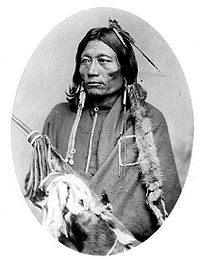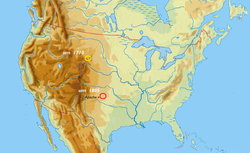- Plains Apache
-
Apache Tribe of Oklahoma Total population 2,310[1] Regions with significant populations  United States (
United States ( Oklahoma)
Oklahoma)Languages English, formerly Plains Apache language
Religion traditional tribal religion, Native American Church, Christianity
Related ethnic groups Apache peoples
The Plains Apache are a Southern Athabaskan group that traditionally live on the Southern Plains of North America and today are centered in Southwestern Oklahoma. The tribe is federally recognized as the Apache Tribe of Oklahoma.
Contents
Name
The Plains Apache are also known as the Kiowa Apache, Naʼisha, or Naishan Dene, meaning "Our People."[2] They also used the term Khat-tleen-deh meaning "Cedar People" or Bay-ca-yeh meaning "Whetstone People"). To their close allies, the much larger Kiowa tribe, although speaking a completely unrelated language, they were known as Semat meaning "Stealers." At major tribal events, the Kiowa Apache formed part of the Kiowa tribal 'hoop' (ring of tipis). This may explain why the Kiowa named the Kiowa-Apache Taugui meaning "Sitting Outside."[citation needed]
Government and economic development
Today the tribe is headquartered in Anadarko, Oklahoma. Their tribal jurisdictional area covers parts of Caddo, Comanche, Cotton, Grady, Jefferson, Kiowa, and Stephens Counties in Oklahoma. They operate one tribal casino, one smoke shop, and the Apache Ink Tattoo Parlor. They also issue their own tribal license plates.[1] Louis Maynahonah is serving as Tribal Chairman,[3] succeeding Alonzo Chalepah.[4]
History
In the late 18th century, Plains Apache lived near the upper Missouri River, their 1780 population was 400.[2] The Kiowa Apache adopted many traits from the Southern Plains lifestyle of the Kiowa, while remaining ethnically distinct. It is recorded that many Kiowa Apache did not learn the Kiowa language, preferring to communicate with their allies using the sophisticated Plains Indian Sign Language, at which the Kiowa were past masters (having probably devised much of the system). The Kiowa Apache social organisation was split into numerous extendend families (kustcrae), who camped together (for hunting, gathering) as local groups (gonka). The next level was the division or band, which was a composite of a some gonkas (especially for warfare).
In pre-reservation times there were at least four local groups or gonkas who frequently joined together for warring neighboring tribes and settlements.
Language
The Kiowa Apache language is a member of the Southern Athabaskan language family, a division of the Na-Dene languages. The Plains Apache language, also referred to as Kiowa Apache, was the most divergent member of the subfamily. While three people spoke the language in 2006,[5] the last fluent speaker died in 2008.
Historical Chiefs
- Gonkon (Gonkan - "Stays in Tipi" or "Defends His Tipi", also known as "Apache John")
- Tsayaditl-ti (Ta-Ka-I-Tai-Di or Da-Kana-Dit-Ta-I - "White Man", ca. *1830 - ca. †1900)
- Koon-Ka-Zachey (Kootz-Zah - "The Cigar")
- Essa-queta (better known as Pacer or Peso, derived from Pay-Sus, ca. *? - † 1875), Peace Chief
- Si-tah-le ("Poor Wolf")
- Oh-ah-te-kah ("Poor Bear")
- Ah-zaah ("Prairie Wolf")
See also
Notes
- ^ a b "Pocket Pictorial." Oklahoma Indian Affairs Commission. 2010: 8. (retrieved 10 June 2010)
- ^ a b Pritzker, 295
- ^ Bryan, Susan Montoya. "Senate Indian panel to discuss racial concerns." Enid News and Eagle. 5 May 2011 (retrieved 14 June 2011)
- ^ "Oklahoma's Tribal Nations." Oklahoma Indian Affairs Commission. 2010 (retrieved 11 April 2010)
- ^ Anderton, Alice, PhD. "Status of Indian Languages in Oklahoma." Intertribal Wordpath Society. 2009 (retrieved 11 April 2010)
References
- Pritzker, Barry M. A Native American Encyclopedia: History, Culture, and Peoples. Oxford: Oxford University Press, 2000. ISBN 978-0195138771.
Bibliography
- Beatty, John. 1974. Kiowa-Apache Music and Dance. Occasional Publications in Anthropology: Ethnology Series. Number 31. Greeley, CO: Northern Colorado UP.
- Bittle, William. 1954. “The Peyote Ritual of the Kiowa Apache.” Oklahoma Anthropological Society. 2: 69-79.
- ______. 1962. “The Manatidie: A Focus for Kiowa Apache Tribal Identity.” Plains Anthropologist. 7(17): 152-163.
- ______. 1963. “Kiowa-Apache.” In Studies in the Athapaskan Languages. (Ed. Hoijer, Harry). University of California Studies in Linguistics vol. 29. Berkeley: California UP. 76-101.
- ______. 1964. “Six Kiowa Apache Tales.” Oklahoma Papers in Anthropology. 5:8-12.
- ______. 1971. “A Brief History of the Kiowa Apache.” Oklahoma Papers in Anthropology. 12(1): 1-34.
- ______. 1979. “Kiowa Apache Raiding Behavior.” Oklahoma Papers in Anthropology. 20(2): 33-47.
- Brant, Charles S. 1949. “The cultural position of the Kiowa-Apache.” Southwestern Journal of Anthropology. 5(1): 56-61.
- Brant, Charles S. 1950. “Peyotism among the Kiowa-Apache and Neighboring Tribes.” Southwestern Journal of Anthropology. 6(2): 212-222.
- Brant, Charles S. 1953. “Kiowa-Apache Culture History: Some Further Observations.” Southwestern Journal of Anthropology. 9(2): 195-202.
- Brant, Charles S. 1969. Jim Whitewolf: The Life of a Kiowa Apache. New York: Dover Publications.
- Jordan, Julia A. 2008 Plains Apache Ethnobotany. University of Oklahoma Press.
- McAllister, J. Gilbert. 1937. “Kiowa-Apache Social Organization.” In Social Anthropology of North American Tribes. (ed. Eggan, Fred). Chicago: Chicago UP.99-169.
- _______.1949. “Kiowa Apache Tales.” In The Sky is My Tipi. (ed. Boatright, Mody). Dallas: SMU Press. 1-141.
- _______.1970. Dävéko: Kiowa-Apache Medicine Man. Austin: Bulletin of the Texas Memorial Museum, No. 17.
- Opler, Morris E. (1969). Western Apache and Kiowa Apache materials relating to ceremonial payment. Ethnology, 8 (1), 122-124.
- Opler, Morris E; & Bittle, William E. (1961). The death practices and escahatology of the Kiowa Apache. Southwestern Journal of Anthropology, 17 (4), 383-394.
- Schweinfurth, Kay Parker. (2002). Prayer on top of the earth: The spiritual universe of the Plains Apaches. Boulder: University Press of Colorado.
External links
Native American tribes in Oklahoma Federally
recognized
tribesAbsentee-Shawnee Tribe of Indians of Oklahoma · Alabama-Quassarte Tribal Town · Apache Tribe of Oklahoma · Caddo Nation of Oklahoma · Cherokee Nation · Cheyenne and Arapaho Tribes · Chickasaw Nation · Choctaw Nation of Oklahoma · Citizen Potawatomi Nation · Comanche Nation · Delaware Nation · Delaware Tribe of Indians · Eastern Shawnee Tribe of Oklahoma · Fort Sill Apache Tribe of Oklahoma · Iowa Tribe of Oklahoma · Kaw Nation · Kialegee Tribal Town · Kickapoo Tribe of Oklahoma · Kiowa Indian Tribe of Oklahoma · Miami Tribe of Oklahoma · Modoc Tribe of Oklahoma · Muscogee Creek Nation · Osage Tribe · Otoe-Missouria Tribe of Indians · Ottawa Tribe of Oklahoma · Pawnee Nation of Oklahoma · Peoria Tribe of Indians of Oklahoma · Ponca Tribe of Indians of Oklahoma · Quapaw Tribe of Indians · Sac and Fox Nation · Seminole Nation of Oklahoma · Seneca-Cayuga Tribe of Oklahoma · Shawnee Tribe · Thlopthlocco Tribal Town · Tonkawa Tribe of Indians of Oklahoma · United Keetoowah Band of Cherokee Indians in Oklahoma · Wichita and Affiliated Tribes · Wyandotte NationTribal languages
(still spoken)Alabama · Arapaho · Caddo · Cayuga · Cherokee · Cheyenne · Chickasaw · Chiwere (Iowa and Otoe) · Choctaw · Comanche · Delaware · Koasati · Hitchiti-Mikasuki · Mescalero-Chiricahua · Mesquakie (Fox, Kickapoo, and Sauk) · Muscogee · Osage · Ottawa · Pawnee · Ponca · Potawatomi · Quapaw · Seneca · Shawnee · Wichita · Wyandot · YuchiRights of Native Americans in the United States Cases Cherokee Nation v. Georgia · Worcester v. Georgia · Standing Bear v. Crook · Talton v. Mayes · Lone Wolf v. Hitchcock · Menominee Tribe v. United States · McClanahan v. Arizona State Tax Comm'n · Bryan v. Itasca County · Hodel v. Irving · Mississippi Band of Choctaw Indians v. Holyfield · Cobell v. SalazarActs Nonintercourse Act · Civilization Act · Indian Removal Act · Dawes Act · Curtis Act · Burke Act · Indian Citizenship Act of 1924 · Indian Reorganization Act · Oklahoma Indian Welfare Act · Indian Civil Rights Act · Alaska Native Claims Settlement Act · Indian Self-Determination and Education Assistance Act · American Indian Religious Freedom Act · Indian Child Welfare Act · Indian Gaming Regulatory Act · Native American Languages Act · Indian Arts and Crafts Act · Native American Graves Protection and Repatriation ActRelated Categories:- Apache tribes
- Native American tribes in Oklahoma
- Plains tribes
- Federally recognized tribes in the United States
Wikimedia Foundation. 2010.



